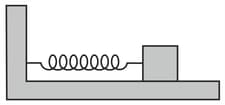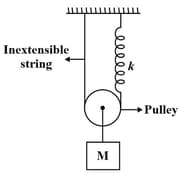Oscillations of a Spring - Block System
Oscillations of a Spring - Block System: Overview
This topic explains the systems executing simple harmonic motion. It elaborates on oscillations due to spring and block system. It also includes an example based on the concept for a better understanding.
Important Questions on Oscillations of a Spring - Block System
Let be the spring constant of a spring. If the spring is cut into two equal parts, then spring constant of each part is
The time period of mass when displaced from its equilibrium position and then released for the system as shown in figure is
A spring balance has a scale that reads from to . The length of the scale is . A block of mass is suspended from this balance, displaced from its mean position and released, it oscillates with a period . The value of is (Take )
Two blocks each of mass , kept on smooth surface, are connected by a spring of spring constant as shown in the figure.

If the blocks are displaced slightly in opposite directions and released, they will execute simple harmonic motion. The time period of oscillation is
Natural length of the spring is and its spring constant is A mass of is hung from it. The extension produced in the spring is
(Given )
A spring having a spring constant of , is mounted on a horizontal table, as shown in the figure. A mass of is attached to the free end of the spring. Then, the mass is pulled sideways to a distance of and released. Determine the maximum acceleration of the mass, and the maximum speed of the mass.

A solid copper sphere is suspended from a massless spring. The time period of oscillation of the system is 4 second. The sphere is now completely immersed in a liquid whose density is 1/8 th that of brass. The sphere remains in liquid during oscillation. Now the time period is

